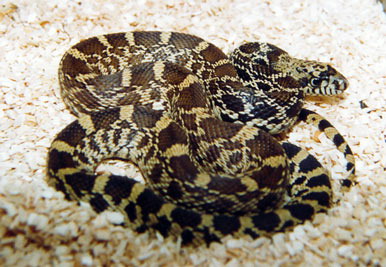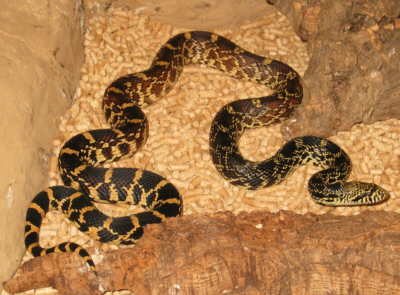|
Besucher:

|
www.pinesnake.de
|
|
|
|
last changes: Sunday, January 06, 2008
|
Bull Snake - Pituophis catenifer sayi
|
 |
|
|
Distribution Map
|
|
The bull snakes live in the middle of North America from the south of Canada (Alberta und Saskatchewan) to the north of Mexico (Chihuahua, Coahuila, Nuevo Leon und Tamaulipas). In the USA it ocure from Montana to Indiana in the north to Texas in the south. To the eastern subpecies they have no contact. In the west they reach and intergrade with the subspecies affinis in Colorado, New Mexico, Texas and the Mexican states Chihuahua, Coahulia and Sonora. In Nuevo Leon they reach the distribution area of the P. deppei jani.
|
|
Discription
|
|
|
 |
41-66 of deep brown saddle spots which brighten a little bit in the body middle are on the back of this firm snake, on the tail are 10-15 spots. There also are populations with throughout black saddle markings in the north of the distribution area. The first saddles in the neck are sometimes connected with each other, all other saddles are clearly seperated. On the side of the snake body there is a row of dark spots between the saddles. Below there is a further row with smaller dark spots. |
| There already is an astonishing frequency range at the natural primary colors: sand-colored up to the firmly red, white to deep brown. After (Wright, 1996) the ground color of the bull snakes is often connected with the mainly colors of the groundsoil. On moist, dark ground mostly live bull snakes wich darker primary color, on lighter, sandy ground live lighter animals with sometimes smaller saddles. Orange/red animals sometimes occure in special mountain areas in Texas. The belly is yellowish with dark spots. On the side of the head there is mostly a dark band from the angle of the mouth to the eye. The sayi usually have saddle markings but also striped and patternless animals have been found in nature.The average lengh lies at about 1,5-2 m, the maximum size is 2.75 m. 1.5 m only seldom exceed by animals in the northern distribution area but the average size gains in to to the south. The monsters of this subspecies come mostly from Oklahoma and Texas. |
 |
The scales are keeld. In middle of the body there are 29-37 scale rows, mostly it are 33.
Speciality in head scalation: 4 scales in front of the eyes (prefrontalia). The snout scale (rostrale) is higher than broad. (Rostrale - Nasale 1:1,5).
|
|
|
|
Habitat
|
|
It lives in various areas like pine woods up to mountain landscapes or half deserts, farm country and river valleys. It occure in heights between 0 mt and max. 2700 mt. The snake inhabits often the tunnels of gopher rats and other rodents, also it lives under stones or wood.
|
|
Way of Life
|
|
The bull snakes are mostly day active and mainly in morning or afternoon they could be watched in biotope. The hot hours of the day are avoid, the animals hide undergroundly usually there. If the summer temperatures get too high, the bull snake transfers her main activity till the time of the sundown until the first night hours. Sometimes it climbs on bushes and trees for food search, otherwise it stay on the ground. Only if there are poor hiding places on ground, it lives in trees. With their enourmous appetite it helps the farmers in pest control – the rodents. More and more farmers accept those snakes as helpers and let them live on their farmland.If the animals are been surprised and disturbed, they show the receipt's indicated defense behavior: The neck becomes s-shape and the is head pulled back, the animals hiss quite loudly and with the tip of the tail vibrate on the groundsoil. If they nevertheless approaches further, they bite. At first it bites with a not full open mouth mostly.The agression resistance sinks, if the surroundings temperature increases.
|
|
Diet
|
|
In the biotop it feeds of various rodents up to the size of half grown rabbits and ground dewelling birds and their eggs. Smaller bull snakes seldom eat also lizards or insects.
|
|
Hibernation
|
|
Because of its great distrubution area this snake lives in several climatic regions. Depending on this the hibernation durination is differnt. In the north and in higher levels it hibernates up to 5 month, in lower and more southern areas those times are shorter.
|
|
Reproduction
|
|
It is mostly like what is written on the page –genus pituophis- . The female lay in an optimal place 5-22 eggs. In hatch they have a lenght of 30 to 50 cm. The coloration is mainly like in adult, but its ground color is a little paler and the spots are a little darker.
|
|
Keeping in Terraria
|
|
|
|
|